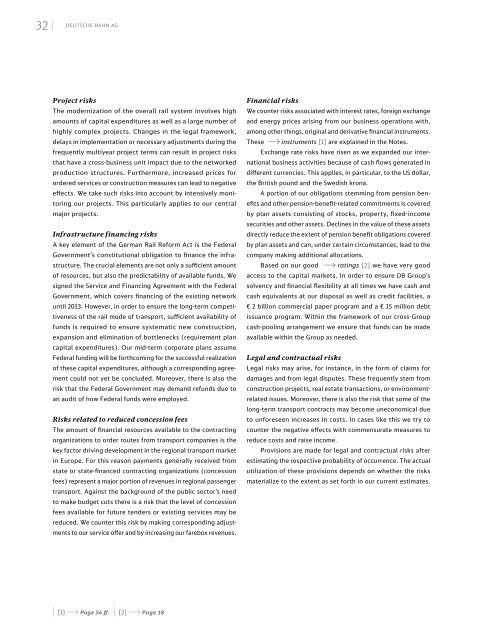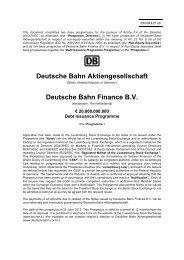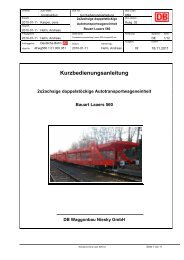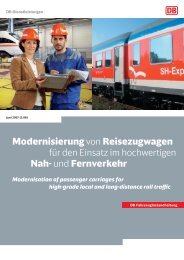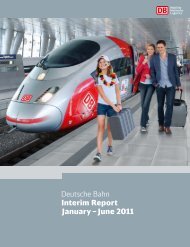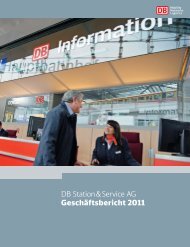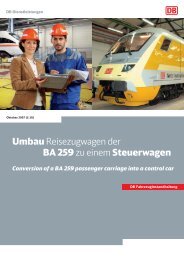PDF Download - Deutsche Bahn AG
PDF Download - Deutsche Bahn AG
PDF Download - Deutsche Bahn AG
You also want an ePaper? Increase the reach of your titles
YUMPU automatically turns print PDFs into web optimized ePapers that Google loves.
32 |<br />
DEUTSCHE BAHN <strong>AG</strong><br />
Project risks<br />
The modernization of the overall rail system involves high<br />
amounts of capital expenditures as well as a large number of<br />
highly complex projects. Changes in the legal framework,<br />
delays in implementation or necessary adjustments during the<br />
frequently multiyear project terms can result in project risks<br />
that have a cross-business unit impact due to the networked<br />
production structures. Furthermore, increased prices for<br />
ordered services or construction measures can lead to negative<br />
effects. We take such risks into account by intensively monitoring<br />
our projects. This particularly applies to our central<br />
major projects.<br />
Infrastructure financing risks<br />
A key element of the German rail reform Act is the Federal<br />
Government’s constitutional obligation to finance the infrastructure.<br />
The crucial elements are not only a sufficient amount<br />
of resources, but also the predictability of available funds. We<br />
signed the Service and Financing Agreement with the Federal<br />
Government, which covers financing of the existing network<br />
until 2013. However, in order to ensure the long-term competitiveness<br />
of the rail mode of transport, sufficient availability of<br />
funds is required to ensure systematic new construction,<br />
expansion and elimination of bottlenecks (requirement plan<br />
capital expenditures). Our mid-term corporate plans assume<br />
Federal funding will be forthcoming for the successful realization<br />
of these capital expenditures, although a corresponding agreement<br />
could not yet be concluded. moreover, there is also the<br />
risk that the Federal Government may demand refunds due to<br />
an audit of how Federal funds were employed.<br />
Risks related to reduced concession fees<br />
The amount of financial resources available to the contracting<br />
organizations to order routes from transport companies is the<br />
key factor driving development in the regional transport market<br />
in Europe. For this reason payments generally received from<br />
state or state-financed contracting organizations (concession<br />
fees) represent a major portion of revenues in regional passenger<br />
transport. Against the background of the public sector’s need<br />
to make budget cuts there is a risk that the level of concession<br />
fees available for future tenders or existing services may be<br />
reduced. We counter this risk by making corresponding adjustments<br />
to our service offer and by increasing our farebox revenues.<br />
| [1] A Page 54 ff.<br />
| [2] A Page 18<br />
Financial risks<br />
We counter risks associated with interest rates, foreign exchange<br />
and energy prices arising from our business operations with,<br />
among other things, original and derivative financial instruments.<br />
These A instruments [1] are explained in the Notes.<br />
Exchange rate risks have risen as we expanded our international<br />
business activities because of cash flows generated in<br />
different currencies. This applies, in particular, to the US dollar,<br />
the British pound and the Swedish krona.<br />
A portion of our obligations stemming from pension benefits<br />
and other pension-benefit-related commitments is covered<br />
by plan assets consisting of stocks, property, fixed-income<br />
securities and other assets. Declines in the value of these assets<br />
directly reduce the extent of pension benefit obligations covered<br />
by plan assets and can, under certain circumstances, lead to the<br />
company making additional allocations.<br />
Based on our good A ratings [2] we have very good<br />
access to the capital markets. In order to ensure DB Group’s<br />
solvency and financial flexibility at all times we have cash and<br />
cash equivalents at our disposal as well as credit facilities, a<br />
€ 2 billion commercial paper program and a € 15 million debt<br />
issuance program. Within the framework of our cross-Group<br />
cash-pooling arrangement we ensure that funds can be made<br />
available within the Group as needed.<br />
Legal and contractual risks<br />
Legal risks may arise, for instance, in the form of claims for<br />
damages and from legal disputes. These frequently stem from<br />
construction projects, real estate transactions, or environmentrelated<br />
issues. moreover, there is also the risk that some of the<br />
long-term transport contracts may become uneconomical due<br />
to unforeseen increases in costs. In cases like this we try to<br />
counter the negative effects with commensurate measures to<br />
reduce costs and raise income.<br />
Provisions are made for legal and contractual risks after<br />
estimating the respective probability of occurrence. The actual<br />
utilization of these provisions depends on whether the risks<br />
materialize to the extent as set forth in our current estimates.


